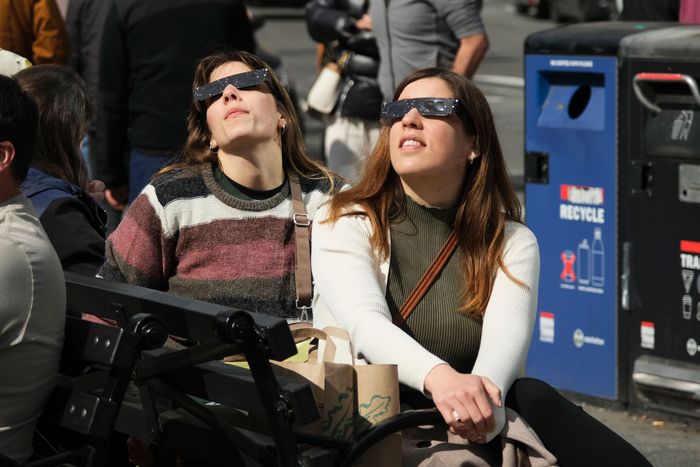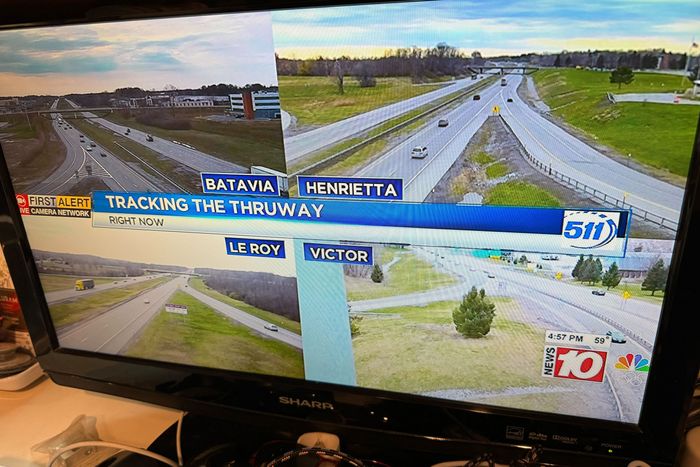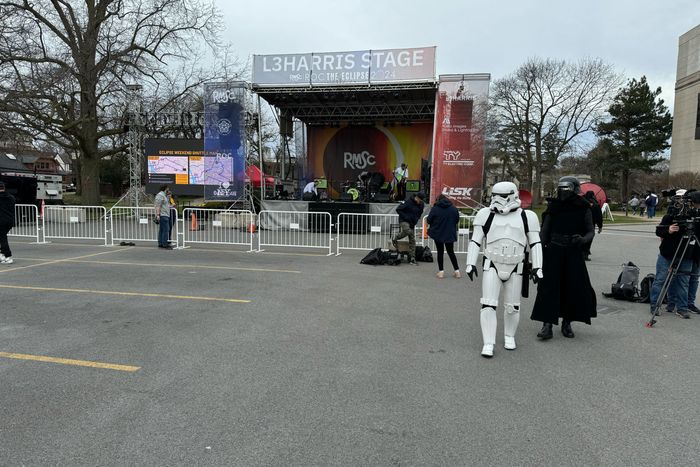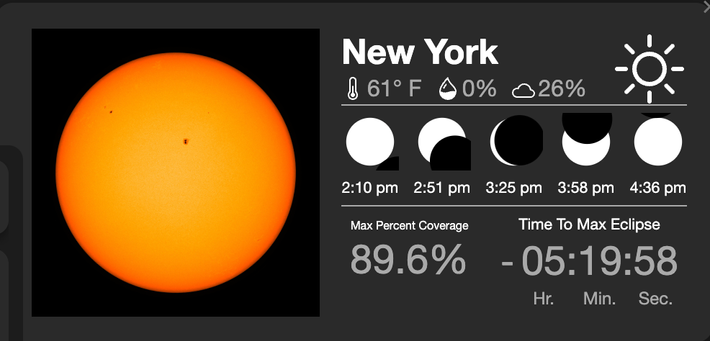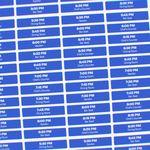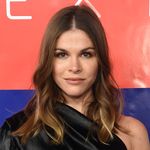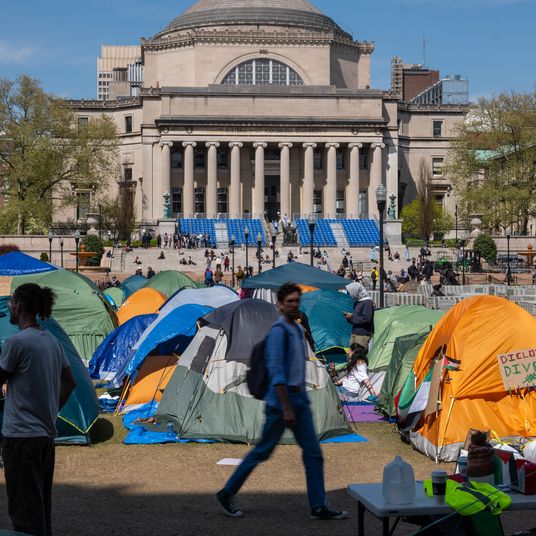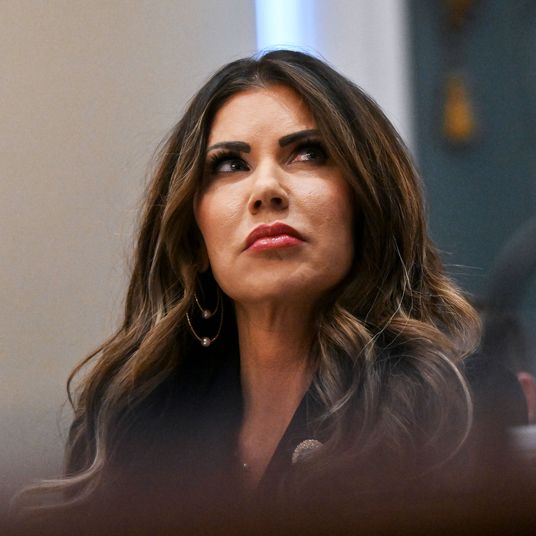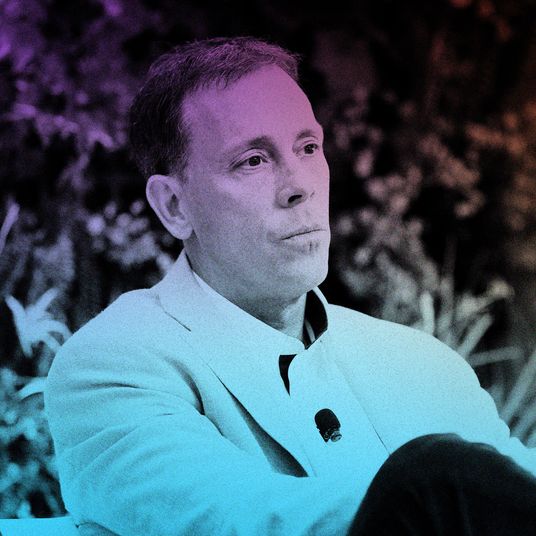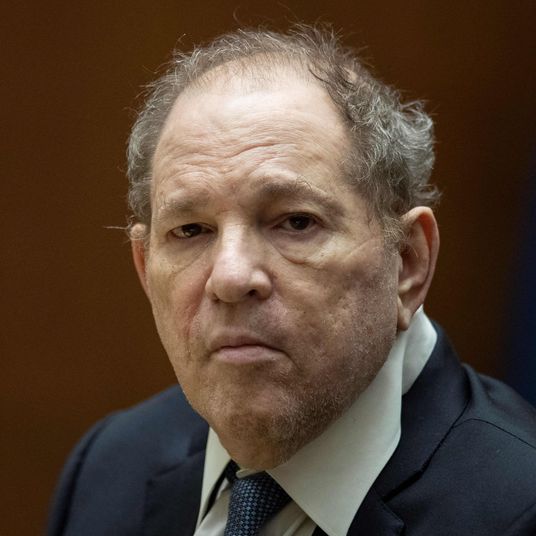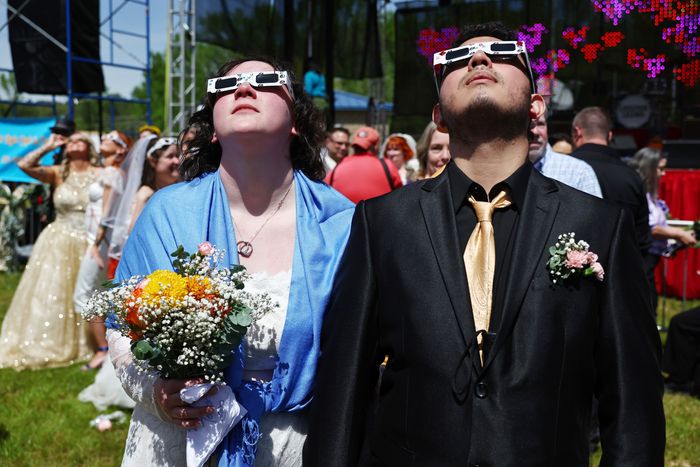
The 2024 solar eclipse is over for a few hundred million of us here in North America — and was an extra-special event for everyone lucky enough to be in the narrow 115-mile-wide path of the total eclipse, and those even luckier to be in places along that path where there wasn’t much cloud cover. Elsewhere, like in New York City, sky gazers were treated to a partial and in some places near-total eclipse. It will a few decades before a total eclipse can be seen again from the continental U.S. Below is a look at how this rare and stunning celestial event played out across the country.
The eclipse is totally over
Here’s what the whole event looked like from space:
The Great New York Lookup
Curbed has put together a gallery of NYC eclipse gazers.
Mayor Adams falsely claims New York is the Burlington, Vermont, of America
Rochester’s glass half-full
They were saying it would be total gridlock. I just went looking for a traffic jam and couldn’t find one. I drove back to the ROC festival and never even hit a red light.
I think everybody must’ve seen the forecast and gone to Vermont.
A time lapse of the totality from the Green Mountain State
Why do my eyes hurt when I look at Google trends?
Despite all the warnings:
The extra-rarity of today’s event
One Giant Leap author Charles Fishman points out something very cool in a thread on X:
Do you have eclipse buzz? Here’s something to understand about how truly special this is: Earth is the only planet in the solar system that has these ‘perfect’ eclipses—where the Moon perfectly covers the sun, but doesn’t quite blot it out.
It’s the science. The space science. What’s happening in the sky today is that the apparent size of the Sun & the apparent size of the Moon are identical. So when the Moon edges across the face of the Sun, it *perfectly* covers the disk of the Sun. Why does that happen?
Here’s why it works: The Sun is 400 times bigger than the Moon. And the Sun is exactly 400 times farther away than the Sun. So in the sky, today, they look the same.
There are ~290 Moons in our solar system. On none of them is that alignment — size of moon, distance to the Sun — aligned in this serendipitous way. This is a special moment solar-system-wide!
Also, this doesn’t happen every month, or every year, because the Moon is tilted relative to the orbits of Earth & Sun. And the Moon’s orbit is elliptical — so the Moon’s distance to Earth varies by 25,000 miles over the course of the year. This is the moment the orbits and the distances align perfectly.
Another committee goes dark in D.C.
The totality in Rochester
Review from my parents’ backyard, which was directly within the path of totality but fully clouded out: Not bad.
It got pretty dark for a couple minutes. Streetlights came on. Birds went nuts. One of the neighbors booed, and another set off fireworks. I’m not sure this was worth the seven-hour drive.
Eclipse mosquitoes in coastal Massachusetts
The eclipse reached 93.9 percent on the North Shore, and as that happened, what seemed like hundreds of the season’s first mosquitoes emerged far more interested in the false-dusk meal of human eclipse viewers than in the celestial phenomena, itself.
Looks like they had a pretty good time in overcast Niagara Falls
Meanwhile, in the city politic
NASA humor
The eerie light of the partial eclipse
It’s not just like somebody hit the sun’s dimmer switch, but a change in the quality of the light as well.
De facto pinhole cameras are everywhere
Lots of extra glasses in Rochester
This a live view of the Rochester sky right now:
No need for those eclipse glasses. They printed 500,000 of them here
Probably how everyone should react to something this cool
And Dallas didn’t totally miss out:
The shadow from space
Another way of looking at it:
Splitting the difference
Knicks players need good vision
Yes.
Later:
The extra-partial view in the Pacific Northwest
The totality makes landfall in North America
On the coast of Mexico, just minutes ago:
The Texas totality nears
Waiting for dark in Rochester
At the Rochester Eclipse festival, with about 90 minutes until showtime, astronaut Lee Morin is warming up the crowd. (He says a space-shuttle launch feels like being rear-ended by an 18-wheeler and estimates that humans will land on Mars sometime in the 2030s.)
There is total cloud cover and absolutely no sun in sight. I’ve heard at least three people wonder if the eclipse has already begun.
Today’s other rare skywatching opportunity
You can see stuff in space you can’t normally see very well, per the Washington Post’s Kasha Patel:
Stars, planets and even a comet will be visible during the total solar eclipse. Venus will be the brightest object, but sky watchers may also be able to point out Jupiter, Saturn and Mars. Mercury will be visible but will appear faint.
People may also have a rare opportunity to faintly see Comet 12P/Pons-Brooks, which orbits the sun every 71 years, especially with a viewing aid like binoculars or a telescope.
And they say eclipses don’t lead to madness
These costumes are even’t close to proper scale:
The moon is throwing some shade at our Blue Marble
Human traffic in Manhattan
Eye safety is definitely worth waiting in line for:
The Great American Solar Eclipse has partially begun!
The view right now down in Texas, where the totality is a little less than an hour away:
But clouds are converging above Austin:
Meanwhile, in cloudy upstate New York
One local police department has created their own doughnut totality:
Is the American animal kingdom about to be really confused?
The New York Times reviews the (limited) science:
How animals will react to solar eclipses can only give hints of animal behavior because the relatively few studies of the topic are often conflicting. One study in 1560 cited that “birds fell to the ground.” Other studies said birds went to roost, or fell silent, or continued to sing and coo — or flew straight into houses. Dogs either barked or whimpered, or did not bark or whimper.
A study of the 1932 eclipse, which was thought to be the first comprehensive research conducted on the subject and included observations from the public, explained that it received “a good deal of conflicting testimony” from people who had observed mammals. It concluded that several animals showed the strongest responses: squirrels ran into the woods and cattle and sheep headed for their barns.
Meanwhile, we humans might freak out our pets just as much as the sudden darkness does:
Most animals will likely be confused by the darkness and will start their nighttime routines, said Dr. M. Leanne Lilly, a veterinary behaviorist at Ohio State’s College of Veterinary Medicine.
But the way humans react to the eclipse — looking at the sky, expressing excitement or gathering in a group — could affect domesticated animals, like dogs or cats, because pets can act strangely when their humans are acting strangely, Dr. Lilly said.
“That can make any of our domestic animals feel like things are not as safe and predictable as they are supposed to be,” Dr. Lilly said, adding that any unusual human behavior can disturb pets because they are “domesticated to attend to us.”
“We might be the problem,” she said, with a laugh.
CBS News talked to some vets:
“Most animals will be overall unaffected by the eclipse, but pet owners may notice brief periods of confusion, and dogs and cats may exhibit fear and confusion,” said Dr. Katie Krebs, a veterinarian and professor at University of Pennsylvania’s School of Veterinary Medicine.
Pets may hide, howl, pace or pant during the eclipse, Krebs said. As the sky darkens, some pets may start their nighttime routine early. The average indoor dog or cat is likely not going to be affected by the eclipse, said Dr. Rebecca Greenstein, veterinary expert with pet care company Rover.
Some traffic jams in sunny pre-eclipse New England
Last-minute eclipse seekers have encountered traffic snarls on various expressways leading north to the path of the totality. It doesn’t seem to have been total gridlock all morning, but definitely slow going in some places, reports the Boston Globe.
Send us your eclipse images!
We want to see what you see today.
So we’re asking readers to send in photos which capture their eclipse experiences — particularly any fun, weird, or otherwise unique images that aren’t just a whole bunch of people looking up. We’ll then try to feature them across the site, including right here on this live blog.
You can email us scenes from your eclipse here, and please don’t forget to note when and where the photo was taken. Thanks!
Biden trolls Trump with an eye safety PSA
Rochester is still turning out, despite the clouds
I’m here in overcast Rochester, New York, starting the day at the Rochester Museum & Science Center’s ROC the Eclipse festival. The lineup includes a performance by the local surf-rock band the Isotopes followed by a speech from NASA astronaut Lee Morin.
The forecast says clouds all afternoon, but parking was still a nightmare and there’s a pretty long line at the gyro truck.
Don’t get an eclipse sunburn, folks
Per NASA, yes, you absolutely can get a sunburn while viewing a solar eclipse:
Even during a partial or annular eclipse, or during the partial phases of a total eclipse, the Sun will still be very bright. If you are watching an entire eclipse, you may be in direct sunlight for hours. Remember to wear sunscreen, a hat, and protective clothing to prevent skin damage.
In other words, having a sunburn on your face, except for an eclipse glasses tan line, is not going to be a good look for anyone. And yeah, you’ll be exposed to a lot of UV radiation, even if it doesn’t seem like it, as a dermatologist recently explained to Healio:
According to [Dr. Allison Arthur], a study was conducted in which 1,000 students at the University of Georgia were surveyed about their skin safety during the solar eclipse in 2017.
“Although the majority of respondents wore glasses to protect their eyes, most did not take measures to protect their skin from the sun,” Arthur told Healio pointing out that only 20.1% of respondents wore sunscreen, 8.5% wore broad-brimmed hats and 4.5% wore long sleeves. …
[T]he researchers calculated that individuals who remained outside to view the 2017 eclipse from start to finish received a dose of 9.7 UVI-hours. In other words, these individuals were exposed to what would be the equivalent of 1 hours’ worth of 9.7 UV light — a value that the WHO considers “very high.”
Is Trump going to stare at the sun again?
At a White House viewing party for the 2017 eclipse, even though he had the special protective glasses, Donald Trump infamously — and stupidly — disregarded everyone’s advice about not staring at the sun (which can cause permanent damage to the eyes).
It’s not clear if he’ll re-create that scene again today. So far, his only acknowledgment of the big 2024 solar eclipse has been to put out a weird campaign ad:
Fox News knows what else is in the path of the totality
The moon’s shadow is now colliding with the channel’s worldview:
Where are the best places to watch the eclipse?
Per the Washington Post’s weather team, as of now, the best places to see the totality will be in northern New England (northern parts of Vermont, New Hampshire, and Maine) as well as parts of Arkansas and Indiana:
Totality locations where skies are most likely to be clear include the area from the northwestern half of Arkansas through south-central Indiana as well as northern New England. A zone from northeastern Vermont to Caribou in far northeastern Maine currently has the lowest predicted cloud percentage among totality locations. Other locations where cloud cover is forecast to be less than 25 percent include Little Rock and Hot Springs in Arkansas, Thayer in southern Missouri and Frankfort, Ind.
And to be clear, even if you can’t see the total eclipse because of cloud cover, or because you aren’t in the path of the totality, this will still be a remarkable event worth going outside for. And a 70, 80, or 90 percent partial eclipse is still really cool.
What’s the best psychedelic rock album to play while watching the eclipse?
If you even need to ask, don’t worry, the internet has you covered:
What time is the Eclipse? How long will it last?
That depends on where you are, but generally, in the path of the totality, where the shadow of the moon will fully obscure the sun, the total eclipse begins in Texas a little before 2:30 p.m. EST (1:30 p.m. CDT) and then move northeast, viewable for a few minutes along the path, until about 3:30 p.m. EST.
The partial eclipse will be viewable earlier and later, both in and outside the path of the totality throughout the country.
NASA has made a super-handy tool for figuring out exactly when you’ll be able to see what, for how long (based on your Zip Code) here.
For instance, in New York City, where nearly 90 percent of the sun will be shadowed by the moon, the partial eclipse start to become visible at 2:10 p.m. EST and reach 89.6 percent at 3:25 p.m., and the sun will fully visible again at 4:36 p.m.:
What’s the latest forecast, regarding the best visibility of the eclipse?
Here’s CNN’s overview, as of Monday morning:
Clouds and storms could hinder the ability to see the eclipse in its full glory in several spots along the path of totality — where the moon will completely block out the sun.
The most ideal weather for the eclipse will likely occur in two general areas: from Vermont through Maine, as well as Missouri through southern Indiana. Only a few isolated clouds are expected for these areas, which should not prevent optimal eclipse viewing. So get your eclipse glasses ready for places like Evansville, Indiana; Carbondale, Illinois; Burlington, Vermont; and Caribou, Maine.
Some of the locations with less-than-ideal weather include portions of the eastern Great Lakes and much of Texas.
Cleveland, Ohio, and Erie, Pennsylvania, have a chance of rain mainly in the morning, but scattered cloud cover may be slow to exit the area even after the rain ends. The extent of the cloud cover all hinges on how quickly a warm front advances eastward.
Farther east in Buffalo and Rochester, New York, cloud cover is expected to be between mostly cloudy and overcast — which will limit the viewing of the eclipse pretty significantly.



